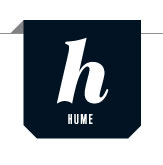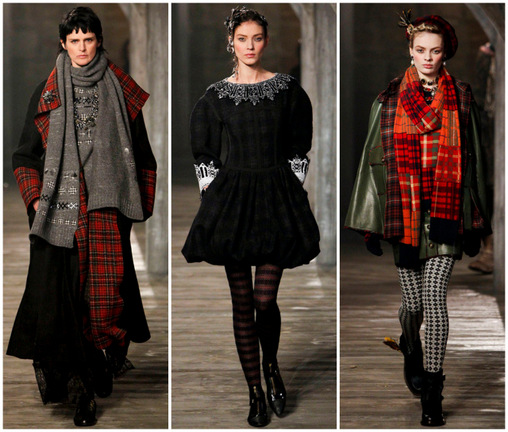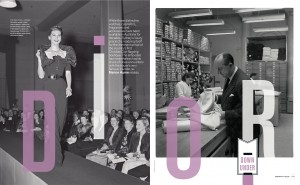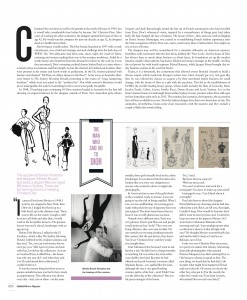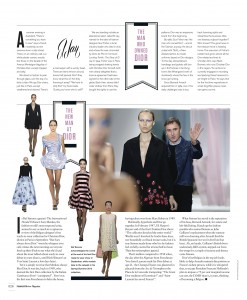Frances Corner, Marion Hume, Maggie Norden, Sasha Wilkins and Lou Stoppard discuss the Jonathan Saunders show on 17 February 2013.
The Auld Country – Australian Financial Review
by Marion Hume
For once, I look more like Chanel than any other woman present and me a big boned six footer while Coco was a little bird. I’m in Scotland, land of my heart, a nation with which Mademoiselle Chanel fell in love while being wooed by the Duke of Westminster, familiarly known as Bendor and the richest man in England, (which, in turn, meant he owned half of Scotland). In the end, Chanel would ditch the multimillionaire but would keep her love for “the auld country” forever.
While they were dating, Coco and Bendor would enjoy long walks through the bonnie purple heather, which inspired a devotion for the rough weaves and the colours of tweed which remain central to the Chanel DNA. It was “North of the Border” that the jaunty French mistress of a naughty rich gent fell for the majesty of tartan, the softness of Scottish wool, the patterns of Fair Isle. And it was up here, in the land of lochs and crags, that Chanel really took to mannish dressing. She’d dabbled before, decking herself in the jersey undergarments of a former boyfriend, but she really crossed over in Scotland.
For salmon fishing at Lochmore, Chanel wore an oversized chunky sweater, warm “trews”, big socks, jack boots and, in a snapshot taken in 1928, a radiant smile. She looked entirely different from the hard, little Parisian of other photographs with the gimlet eye of ambition, the jaw fixed in grim determination, the armholes of her jacket cut high and tight.
It is Chanel’s joyful Lochmore look I have gone for tonight because we are instructed to wrap up warm. I’ve added a huge broach, which looks as if it was hammered and forged by the Pictish men of the dark hills; in truth, it was dug up with delight, at Christine Barro’s treasure trove in Melbourne.
Snow falls on the location, a roofless, ruined castle. Karl Lagerfeld has invited us to witness a fashion show inspired not just by the brand’s long history of Scottish production but also by its life-saving purchase, last August, of Barrie Knitwear, which makes Chanel’s cashmere twinsets. A pension fund crisis in the conglomerate by which it was owned had bought Barrie to the brink. Chanel added it into its charm bracelet of specialist companies, the Metiers d’Art, acquired in order to preserve the savoir faire of glove makers, feather makers, milliners, goldsmiths. “It’s a dream,” says managing director, Jim Carrie, who feared he was headed for the block.
That was the grim fate of Mary, Queen of Scots, born here at Linlithgow Palace and whose every living heartbeat brought her closer to her cousin, Elizabeth I, sending horseman North with orders for her execution. The models in the show wear their red hair plaited upwards, tight to their scalps, keeping their necks clean for the axe. Scotland changed Chanel. Its haunting highland spell softens Karl Lagerfeld, who modernises the traditional in his most beautiful show in 30 years with the brand. Models hurry past, their chiffon gowns held by kilt fastenings, wrapped up against the weather in vast tartan scarves and bonnets. Never, in all my years of singing Auld Lang Syne to see in the New Year did I expect that the Chanel bag du jour would be a sporran rendered in golden chain mail or that Hogmanay vocabulary like tam o’shanter, ghillies and sgian dubh (men’s bonnet, brogues and the knife you stick on your kilt socks) would become a useful part of my lexicon in the high speed frenzy of the front row.
The “Auld Alliance” between France and Scotland was forged way back in 1295. The show’s title is Paris Edimbourg, to me, thrilling proof that the age-old pairing between the land of my work and the land of my blood stays strong.
Dior Down Under – Australian Financial Review
Dior Down Under
While those distinctive watches, cosmetics, fragrances and accessories have been available in Australia for decades, Sydney’s luxury precinct is readying itself for the imminent arrival of the country’s first Christian Dior flagship boutique. The antipodes has nevertheless had its share of close encounters with the house’s very famous founder, as Marion Hume relates.
The Australian Financial Review | December 2012
by Marion Hume
Heart Of Glass – Australian Financial review
by Marion Hume
Sometimes an adventure beckons and you have to follow the lead. When an interview was relocated from New York to Prague, I was thrilled, given I haven’t been to the Czech Republic since it was Czechoslovakia. I looked forward to going again to the mighty Prague castle, to walking the span of the historic Charles Bridge.
But then a half-lost nugget of something began to niggle. When, recently, had there been mention of something Czech? I realized it was a few weeks before, in Kenya, when I was watching Maasai women working their magic on a range of bags for Myer, including designs by Karen Walker, Fleur Wood and Jayson Brunsdon.
Maasai beading is every bit as good as in the ateliers of the Paris haute couture. (How lucky am I, to have witnessed both, and often). This is due to a mix of traditional skill and sheer bloody-mindedness. The Maasai won’t even touch beads from India or China (whisper it, but the French will). Only the Czech ones are perfect.
Today, glass seed beads are still traded through second, third, fourth parties, so it has taken a degree of investigative skill to trace the source to where I am standing now, inside an old glass foundry, up a mountain, near a village I will never learn how to pronounce. Getting all the way here from Prague has taken guts and the navigational skills of a girl scout (Ok, that’s not true, but it has required the essential fashion skill of knowing how to hire a cheap driver with a GPS).
Inside, it is roasting hot, as you’d expect when five furnaces hit over 1,000 degrees. What looks like needle-thin vermicelli is being extruded (protuded? Who to ask for vocab when I can’t speak Czech?) along thin, raised contraptions that stretch as far as the eye can see. The secrets of glass reached Bohemia from the Venetian isle of Murano. But they will get no further today. How does this clear vermicelli become tiny beads of more colours than I can describe? Before I work that out, I am ushered outside into the icy cold. With every step I take there’s the crunch of glittering fragments of glass, sparkling under my feet.
Where I am welcomed, warmly and officially, is at the offices of Preciosa Ornela from whence all top-end traditional seed beads, known as rocailles, hail. (Preciosa Ornela, best know for glass figurines, bought out an ailing company called Jablonex which pioneered rocailles). These beads range from so teeny, they are given the measure 13/0 – a percentage of a millimetre – to 4/0, which is just about big enough for me to see without glasses.
Over eggs, ham and pickles, my hosts explain the reason Preciosa Ornela, and previously Jablonex and originally, the way more famous Swarovski, (a Czech company before moving to Austria) all hail from a cluster of tiny mountain villages. While glass is hard work, it doesn’t need many people. What it did need, traditionally, was wood, sand and water a-plenty. Given the Venetians soon ran out of wood, that this landlocked region of icy streams and forests always had to import sand (today a complex mix of chemicals) soon made the competition about even. But while the venetians lent more towards chandeliers, here it was beads and buttons. Thence, from the top of this mountain, traders ventured around the world, all the way to Mexico, China, India and East Africa.
“But the world we have never conquered is fashion,” my hosts lament, comparing to the spectacular style success of Swarovski. That’s when I reveal that Vivienne Westwood evening clutch bags and Sass & Bide tote bags are beaded by the Maasai through the United Nations Ethical Fashion Initiative in Kenya. My hosts are utterly delighted – although not as delighted as my Maasai mates will be when I hand over the new season’s disco beads in shimmering gold, bronze and silver.

